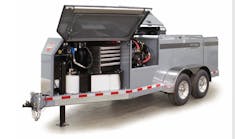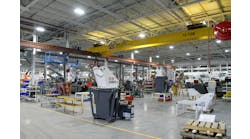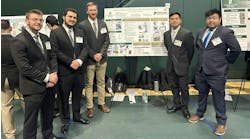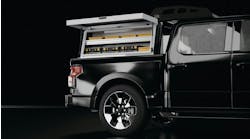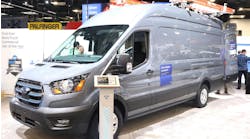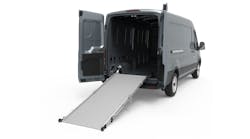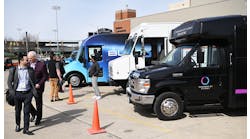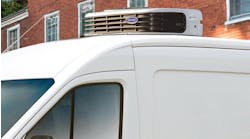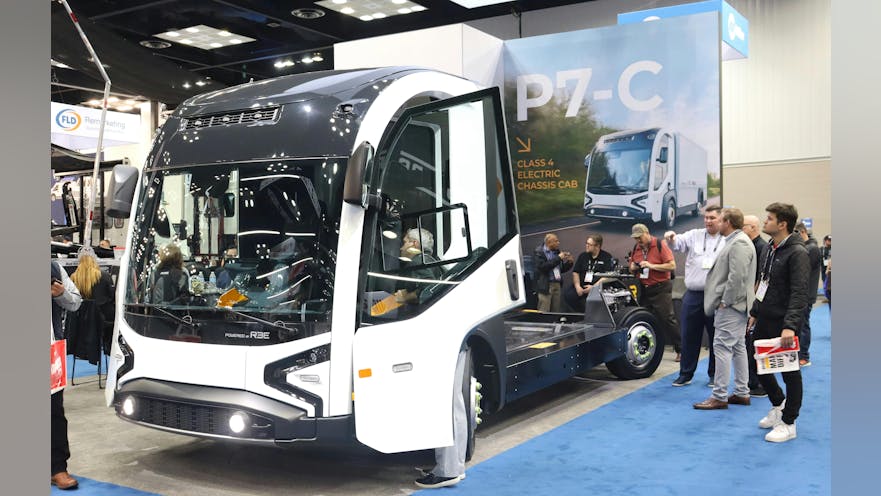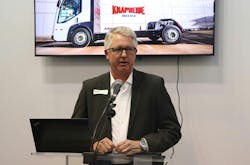INDIANAPOLIS—REE Automotive’s electric commercial vehicle platform, with unique “x-by-wire” drive, steer, and brake technology, makes it fleet ready, dealer ready—and upfit ready, according to REE co-founder and CEO Daniel Beral. And the EV-like speed at which its recent project with Knapheide coalesced—just in time for NTEA’s Work Truck Week 2024—verifies the vehicle’s ability to accelerate customization.
The result, a P7-C chassis with a KUVcc utility body, was on fully independent display during Knapheide’s annual distributor meeting held March 5 at the Crane Bay Event Center in conjunction with the industry’s largest trade show. “It’s a really clean execution of the product—and the chassis made it easy to build,” Mandar Dighe, Knapheide vice president of sales and marketing, told Trailer/Body Builders.
The Class 4 zero-emission truck was well-received by the representatives of Knapheide’s 280 distributors who traveled here, Chris Weiss, Knapheide VP of engineering, said at a media gathering inside the Indiana Convention Center exhibit hall. And REE’s 17 authorized North American dealers—one of which commissioned the demonstration unit—are equally enthusiastic, helping the manufacturer secure 300 binding orders worth $40 million, reported Jake Obert, REE senior director of sales.
REE expects the P7-C to enter U.S. production later this year, Obert said.
“They pushed hard to get this vehicle ready, and we worked closely with them the past several weeks to make sure the integration went smoothly,” Obert told Trailer/Body Builders. “But, really, it’s super upfit-friendly for any body manufacturer.”
‘Unique’ upfit opportunity
Knapheide, a 176-year-old, family-owned body builder, always is working with multiple manufacturers to develop body programs for new chassis, Dighe said, and many of those chassis OEMs now are electric-vehicle makers, added Haily Meyer, Knapheide manager of solutions engineering, who led the project.
“We partnered with REE, starting last year, because we saw a unique opportunity,” Weiss explained. “One of the key things we talk about is, how do you take great technology … and make it a turn-key work truck solution for the customers? They still have to do the same work—and be green at the same time. So what we’ve done with our engineering group is share the data, and we’ve used their upfitting technology to make it very easy to adapt our work truck solutions down into the REE vehicle.”
REE produced the chassis cab in December, and Knapheide added the body and certified the completed 16,000-lb. vehicle to Federal Motor Vehicle Safety Standards in February at its Quincy location. The vehicle weighed 10,000 lbs. before the upfit, Meyer said, and Knapheide used a steel body to expedite production. “Aluminum would have required more testing for a body that big,” Meyer said, adding that his team already is working on an aluminum version of the P7-C upfit that will shave 1,000 lbs.
The chassis design also simplified execution. It features a low, flat floor, minimizing the need for additional mounting hardware, and integrated weld nuts allow upfitters to attach a body directly to the frame without drilling. The “skateboard” concept also eliminates mechanical connections between the “REEcorner” wheel modules, and the batteries are placed inside the frame, further facilitating upfits. “When the batteries are positioned outboard of the chassis rails, that can create interference with cabinets and boxes, so we try to avoid that,” Dighe said. “With the REE chassis, the batteries are down the middle, so they’re internal to the chassis rails, which makes it easier to put a body on.”
Finally, the P7-C’s “plug-and-play” system interface streamlines technology and accessory integration, Meyer affirmed.
“With EVs, the construction of the body isn’t the biggest issue,” he said. “It’s more about, how do we deal with the electrical systems? What kinds of accessories are going on there? If we put a liftgate on, how are we going to drive that liftgate from the 12-volt chassis, and all those kinds of considerations.”
‘Revolutionary’ vehicle design
REE’s corner modules make the P7-C upfit and maintenance friendly, Barel insisted. Each REEcorner contains the critical steering, braking, suspension, and powertrain components, all integrated into a single, independently controlled unit maintenance personnel can swap out in less than an hour. Electronic, “by-wire” controls further reduce total cost of ownership and improve safety and efficiency, he said.
“That corner is common in all four corners of the vehicle,” Barel said. “So our dealers and our fleets only have to stock a couple corners, and that basically provides them the ability to service the whole fleet.”
Other features include a 39-ft. turning circle for greater maneuverability; all-wheel-drive regenerative braking; and an expansive, high-roof, low-floor cab with large, heated windshield. “We’re not just making the vehicle electric—we’re making the commercial vehicle better,” Obert maintained. The P7-C’s 400-volt battery delivers 536 horsepower, 8,628 lb.-ft. of torque, and 150 miles of range, REE said.
“We’re very different because we’re a tech company in the automotive world, so we bring revolutionary tech into the industry,” Barel said.
Unconstrained collaboration
Adapting Knapheide’s bodies for electric vehicles remains “a learning experience,” Meyer cautioned, and the manufacturer isn’t focused exclusively on developing EV bodies, though the segment’s growth is “undeniable,” Dighe shared. “We’re going to meet the needs of whatever OEMs decide is the right powertrain choice,” he said. “So whether it’s internal combustion, electric, hydrogen, or whatever the next power source is, we try to stay ahead of it by working with OEMs to understand the physical constraints of the technology, and what that means for the body—and go from there.”
Still, the REE platform’s lack of constraints make it highly conducive to upfit collaboration, Knapheide’s leaders agree, so it’s already developing a full line of P7-C bodies.
“It was a great process working together to develop our body around their chassis,” Weiss said in a news release. “It’s one thing for a company to give us a cab chassis and ask us to upfit it, it’s another to actually partner with the manufacturer to come up with a solution ahead of time. The REE P7-C comes to us ready to go—for example, there is a series of threaded inserts so that our body is mounted directly to the frame rails. By working together for every step of the process, we’re able to create a really custom and seamless process for the REE P7-C and any future fleet customers.”
